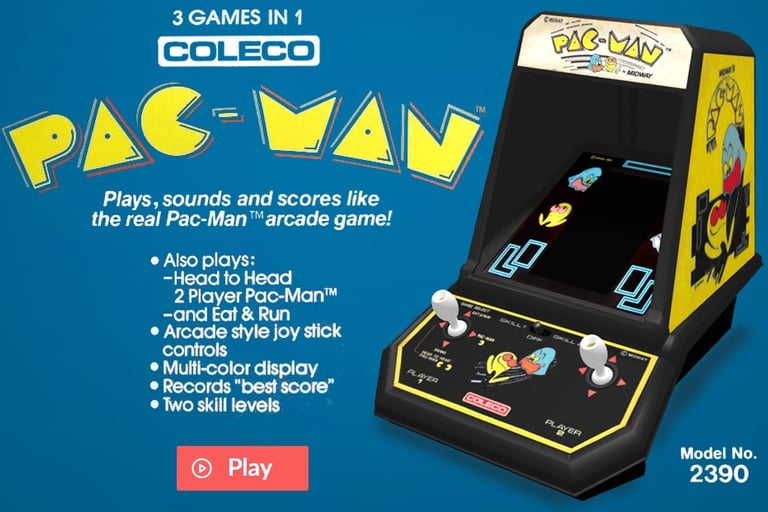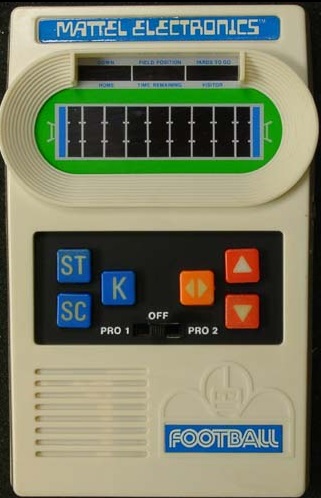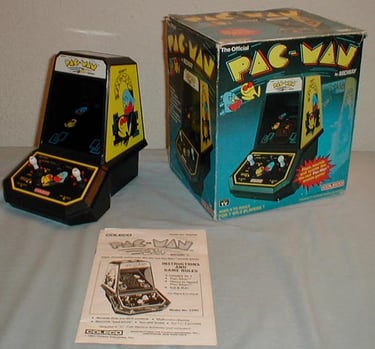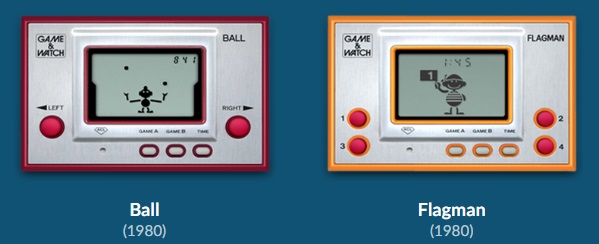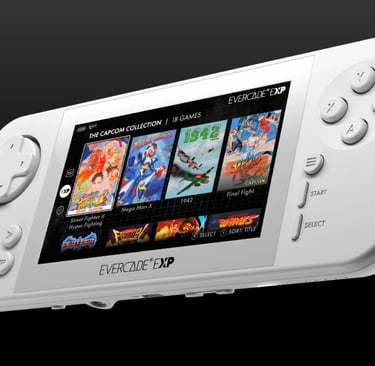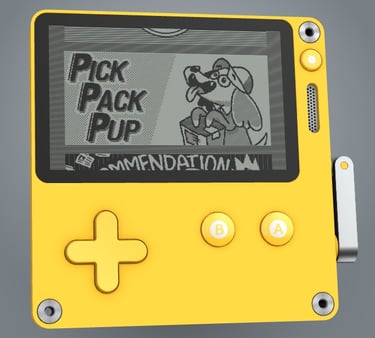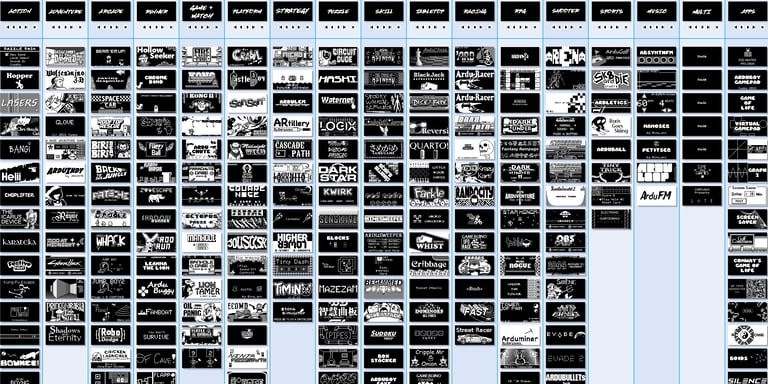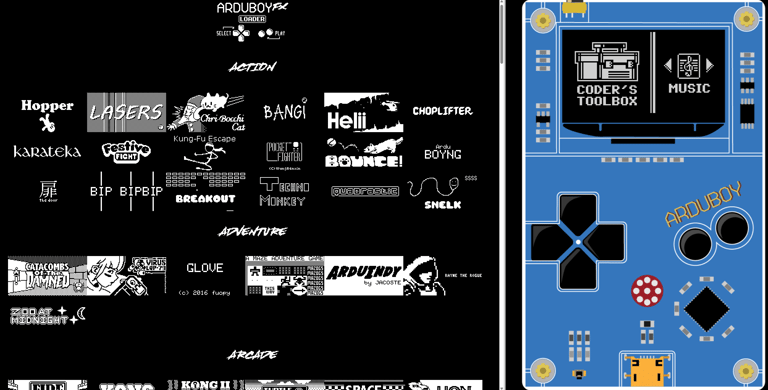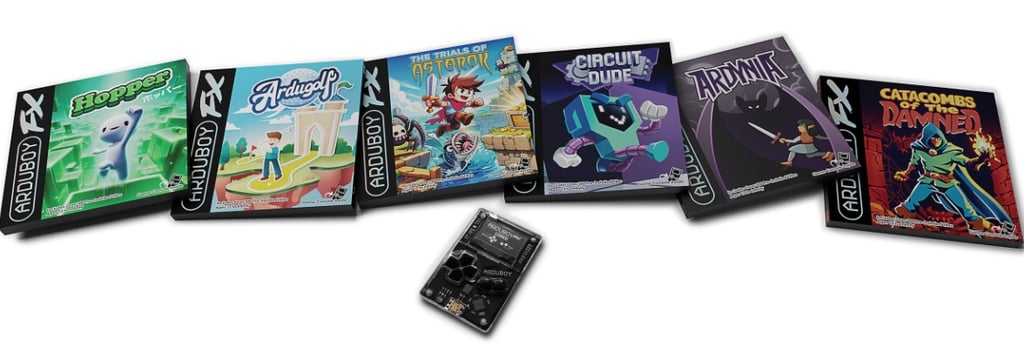
Arduboy FX - The Future of Pocketable Gaming...or just a Cute Curiosity?
- More prototype and learning tool than full-fledged retail product, the Arduboy is a worthwhile device that still feels a mite unfinished.
Specs (and a little more history)
A full recounting of the device’s history can be found on the Arduboy website. But it’s essentially an Arduino-based platform devised by a certain Kevin Bates, an obviously gifted fellow who originally imagined his creation as being a kind of “digital business card.” Instead, it became a super cute gaming device he eventually crowdfunded through Kickstarter. The original version became available in 2016, capable of only holding one game in memory at a time. A later edition, the Arduboy FX, would remedy this obvious shortcoming, coming prepackaged with over 200 games along while retaining the ability to upload more. The most recent version of the Arduboy FX includes even more titles, with a built-in library of 300+ titles for gamers to digest.
The system’s specs:
Processor: ATmega32u4 (the standard Arduino Leonardo chip)
Memory: 32KB Flash, 2.5KB RAM, 1KB EEPROM
Inputs: 6 Momentary Tactile Buttons
Outputs: 128x64 1Bit OLED, 4 Ch. Piezo Speaker and Blinky LED
Battery: 180 mAh Thin-Film Lithium Polymer
Connectivity: Micro-USB 2.0 with built-in HID profile
Programming: Arduino IDE, Arduboy Game Loader, GCC and AVRDude
Being based on the Arduino architecture and philosophy, owners of the Arduboy are strongly encouraged to develop their own games. Indeed, the system’s vast library of software is largely a homebrew repository. Development is said to be relatively easy, but for this reviewer…just one look at an early tutorial was a cold reality check. Easy or not, coding a successful game will require finesse, talent, and, probably, some prior experience.
The gaming handheld has a legacy that extends back to the 1970s. Even before video games had become a popular commodity and form of entertainment, companies like Coleco and Tiger Electronics were creating portable gadgets that provided the semblance, or at least the suggestion, of digital gameplay. The earliest of these systems didn’t use graphics or even conventional screens. Mattel’s Football, for instance, used a playfield simply comprised of tiny LEDs—little red dashes that would turn on or off to simulate movement. It was incredibly primitive, and somehow, incredibly effective.
These portable units of fun quickly evolved throughout the 1980s. The most famous might be Coleco’s tabletop line of arcade units and Nintendo’s clever Game and Watch devices. The former used a Vacuum Florescent Display while the latter used pre-printed LCDs. And for the time, they offered the best portable “gaming” experiences available.
Except for the Microvision. Released in 1979, the rectangular contraption used a full 16x16 LCD display and took interchangeable cartridges. Compared to the competition, it was years ahead of its time…which, perhaps, brought its demise. It was too much, too soon, for a public still barely acquainted with the notion of “electronic game” in any form. But Nintendo, inspired by the gadget’s tech, would create its own version in 1989. Dubbed the Game Boy, the Big N’s unit would essentially furrow the home gaming industry into separate if complimentary halves: the console side (Super Nintendo, Sega Genesis), and the handheld portion (Lynx, Game Gear).
Years later, handheld devices are everywhere, and games play a huge part in their existence. Tablets and smart phones are now a mainstay of daily life, but in the last ten years, the dedicated gaming portable has been reemerging as a real and tangible force. Nintendo’s Switch aside, various smaller developers have been experimenting with their own handheld devices, creating niche markets and communities in the process. Blaze Entertainment’s Evercade EXP. Panic’s Playdate. And New Wave Toys’ Replicade line.
But perhaps the most unsung is, in some ways, the coolest. Released in 2016, the Arduboy is a credit card-sized gaming device sporting a black and white display and a sturdy 8-bit processor. Though similar to Nintendo’s Game Boy in appearance, it nixes the cartridges for a more modern solution—by connecting the unit to a PC, literally hundreds of games can be downloaded to its memory. In many ways, it’s the kind of device many assumed Nintendo itself would do. And yet, despite some early media buzz, the little machine is relatively invisible.
The late '70s, early '80s saw a surge of handheld gaming...albeit of a limited nature. Mattel's Football proved exceedingly popular, while Nintendo cracked the Western market with its Game & Watch line of miniatures. Coleco was perhaps the most ambitious, attempting to recreate full arcade games within the pre-printed constraints of its VFD displays.
The site RetroFab by Itizso offers an excellent selection of handheld gaming recreated to play in a browser. Lag plagues some of the titles (Game and Watch, sadly), but it's still an amazing interactive gallery of vintage esoteria.
The Evercade is a recent example of a modern, non-Nintendo gaming handheld meant to play simpler, classic-styled games.
The Playdate is another example of an indie handheld trying to do something different. Games can be played via the traditional d-pad...or that crazy-looking crank.
The Arduboy's Ancestors - Fifty Years of Handheld Evolution
Meet the Arduboy - Tiny Device, Petty Specs
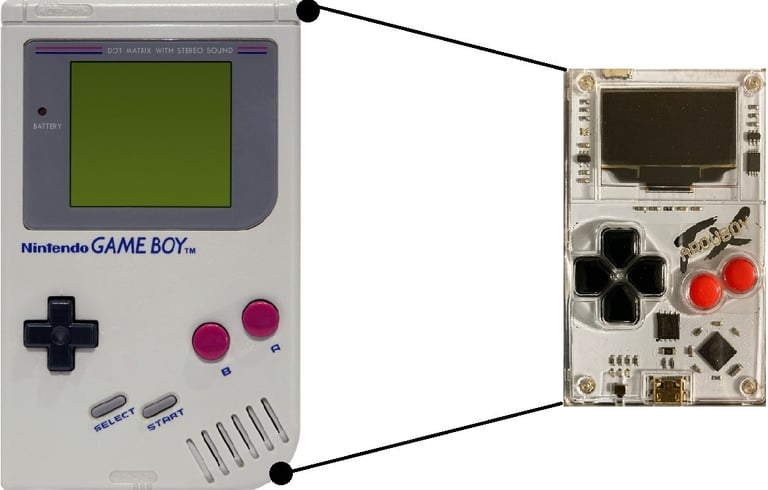

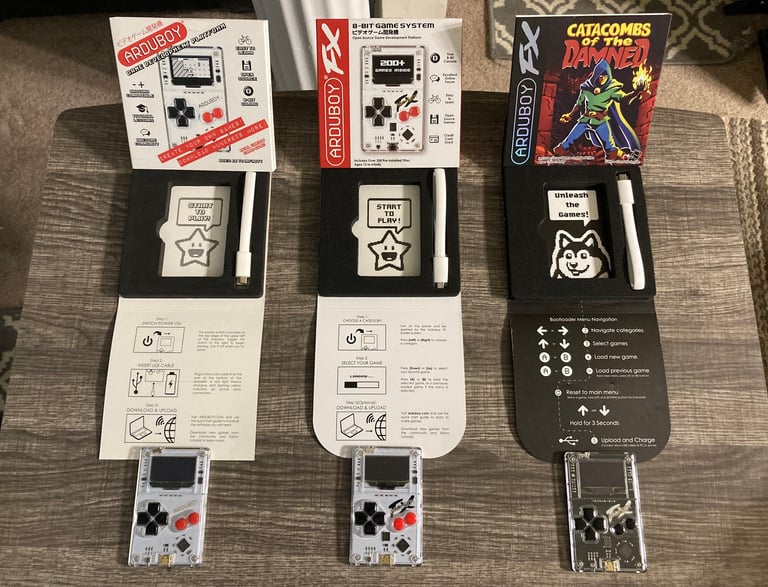

Nintendo's Game Boy is the obvious inspiration, but the Arduboy is no clone, being significantly smaller and thinner in build, and much more "homebrew" in orientation and purpose.
The Arduboy has seen three main releases, shown here chronologically from left to right. The original had to be reflashed each time a new game was loaded, a serious shortcoming remedied in the later "FX" models.
For most users, the Arduboy will be less of a development platform and more of a niche collage of quirky, homespun efforts designed for a very unique and restrained device. Although ostensibly built to resemble a Game Boy, the Arduboy’s screen lops off about a third of the former’s real estate, allowing for a much “squatter” range of play. It’s a peculiar decision that perhaps limits not only the graphical potential of the system, but also the gameplay of certain games—there simply isn’t enough space to allow for detailed, expansive playfields.
Nevertheless, designers have released some truly remarkable efforts that, just like the best homebrews should, seem to defy the system’s inherent limitations for something truly transcendent. The Arduboy website highlights a few of these noble, system-selling titles: Hopper, Ardugolf, The Trials of Astorok, Circuit Dude, Ardynia, and Catacombs of the Damned. These games, and the entire Arduboy library, can be played in-browser here, but naturally, the games are best experienced within their default, limited dimensions.
Originally, the Arduboy was meant to be a single-game flasher—download a game, play it, then exchange it for another. And yes, this made the Arduboy a rather arduous system for experiencing its full library. The Arduboy FX was designed to alleviate some of this burden; with now over 200 games pre-installed, a player's favorite was likely accessible right at purchase. And if they wanted to add more titles, they could do so easily without losing the selection already in place. The Arduboy FX Special Edition would come later, boosting the pre-loaded title count to over 300.
This section will attempt to compare the default menu and game selection of the two units, and then highlight some of the pair’s best entries.
The Arduboy FX v. Arduboy FX Special Edition
The Arduboy FX can be played virtually in a browser, allowing the curious to explore its preloaded array of games as initially shipped. Considering this version of the device is now discontinued, the site is an excellent source of gaming preservation.
The Arduboy FX Special Edition has its own virtual browser featuring every default preloaded title. Most games from the original FX have been retained in this newer version, plus about a hundred new ones.
Arduboy FX - Game Count Per Genre
Arduboy FX Special Edition - Game Count Per Genre
Action - 18 Games
Adventure - 7 Games
Arcade - 27 Games
Runner - 13 Games
Platform - 16 Games
Strategy - 4 Games
Puzzle - 19 Games
Skill - 23 Games
Tabletop - 13 Games
Racing - 6 Games
RPG - 14 Games
Shooter - 29 Games
Sports - 5 Games
Music - 6 Games
Apps - 23 Games
Tools - 10 Games
Overall Total: 233 Games Pre-Installed
Action - 30 Games (13 New)
Adventure - 10 Games (3 New)
Arcade - 26 Games (9 New, 3 Removed)
Runner - 13 Games
Classic [New Category] - 12 Games (4 New, 1 Moved Over from Action, 7 Moved Over from Arcade)
Platform - 19 Games (3 New)
Strategy - 9 Games (5 New)
Puzzle - 30 Games (10 New, 2 Removed)
Skill - 30 Games (8 New, 1 Removed)
Tabletop - 14 Games (1 New)
Racing - 11 Games (5 New)
RPG - 21 (6 New)
Shooter - 41 Games (12 New)
Sports - 7 Games (2 New)
Music - 8 Games (2 New)
Apps - 36 Games (16 New)
Tools - 14 Games (1 New, 3 Moved Over from Apps)
Overall Total: 331 Games Pre-Installed


Final Thoughts on the Gaming Tot
The Arduboy is a neat device. But, in a world of Nintendo Switches and cheap Chinese retro-styled handhelds, is there a place for such a boutique, unique…and restrictive piece of tech?
Indeed, more than the Arduboy being too small, the unit’s screen is too squished, a restriction that costs it in both visibility and aesthetic potential. Even the most talented artists struggle with the system’s thinned dimensions and two-tone palette, and with other software packages like GB Studio and Pulp (two game-maker programs for the Game Boy and Playdate, respectively) offering fans greater reach and possibilities, these limitations seem more criminal than whimsical.
But, of course, this review is coming well after the system’s prime; in 2016, the Arduboy was a cleverer device, a quirky alternative to Nintendo’s 3DS and Sony’s (failing) Vita. But times change; before one even considers the Nintendo Switch, Valve’s Steam Deck, the Evercade or the Playdate, heaps of sweet gaming devices can already be had on Amazon.com at $50 or less. And then there’s the Analogue Pocket. The Super Pocket. The Replicades and Quartercades and Sony’s PS5 Portal. The innumerable mobile phones and tablets and VR wearables also clogging the market. It’s a clutter that leaves the Arduboy not only buried circa late 2024, but almost irrelevant. A cute conversation piece, sure, but without the supporting commercial talent needed to grow itself beyond being a mere curiosity or, at best, a learning tool.
In truth, “niche” and “kitsch” don’t summon a phenomenon, only a fad. And eight years later, that’s exactly what the Arduboy proved itself to be—a nifty, boutique piece of gadgetry that inevitably lost its tenuous, hair-thin slice of the zeitgeist.
Can the Arduboy be saved, revived…redeemed? At this late stage, probably not—it needs a reinvention, a sequel machine that can elicit more than mere curiosity from its potential consumer base. A bigger screen, better audio, more sophisticated games, easier development tools, maybe a way to project the games onto a larger display…the next Arduboy can’t just be another “FX Special Edition Ultra Mix.” It needs to be the Arduboy 2.
And, oh yeah, it needs to be good. Really good.--D
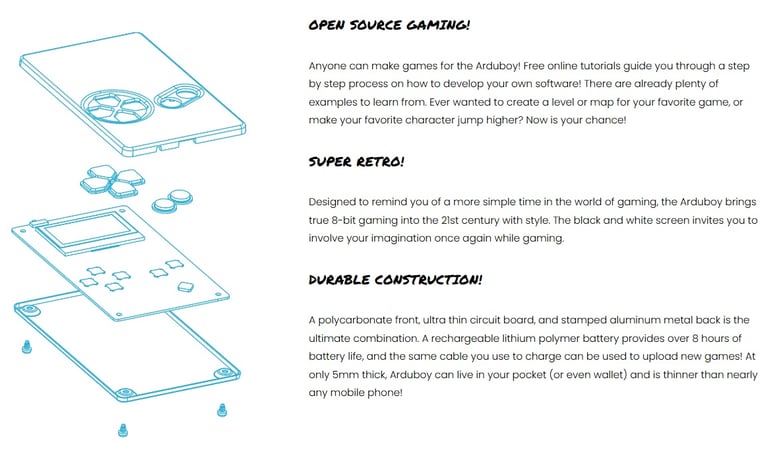

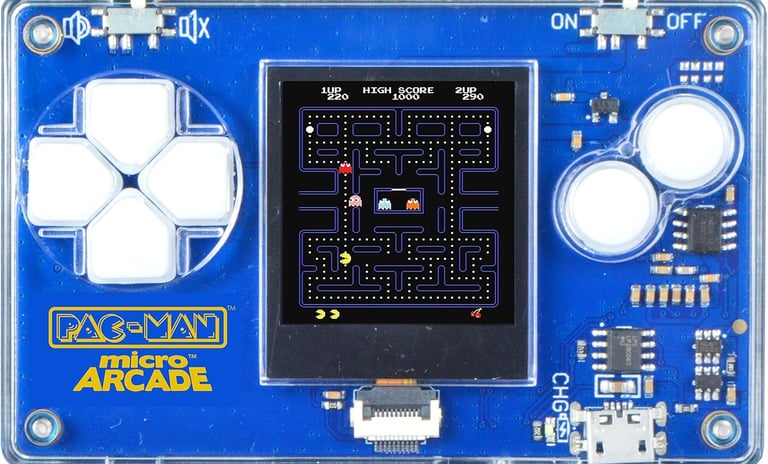

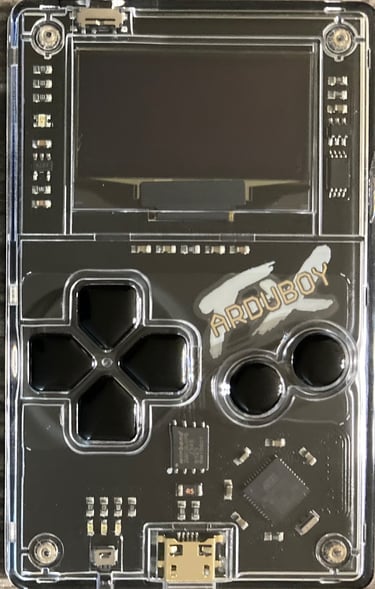

The Arduboy FX Special Edition - the current iteration of the device. Will there be more...or is this the last gasp of a desperate gadget?
The Arduboy dissected. Impressive or just a mess?
Company Super Impulse licensed the Arduboy wafer-thin tech for its own line of dedicated handhelds. They were received with mixed reactions, but at least the price was fair ($20 - $25).
The Arduboy website touts these six games as its best...even offering special packaging for FX Special Edition purchases.


Contact: lostnostalgiaproductions@gmail.com
Website: www.lostnostalgia.com
Like what we're doing? Please consider throwing us a dollar into our Patreon page's tip jar!



